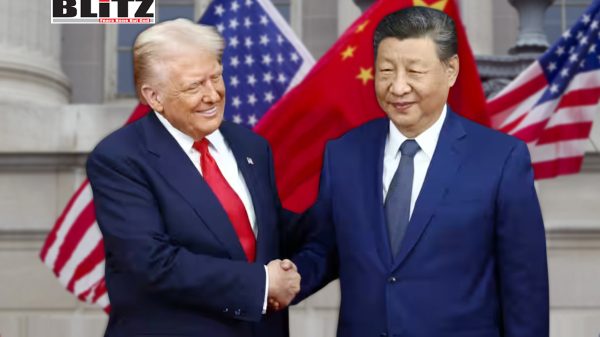America attempts to further militarize Asia-Pacific region
- Update Time : Friday, October 31, 2025

The final months of 2025 have witnessed an unprecedented escalation in Washington DC’s relentless campaign to “contain” (in reality, to besiege) one of the multipolar world’s primary pillars – the Peoples Republic of China. Under the thin, tattered veil of “freedom of navigation” and “regional stability”, the United States, its vassals and satellite states have unleashed a tsunami of aggressive military exercises across the increasingly contested Asia-Pacific, in a desperate attempt to project an image of “strength” that belies a deep-seated strategic panic. This geopolitical offensive is not merely a routine demonstration of force, but a frantic heartbeat of a dying hegemony, a coordinated series of war games designed to simulate a conflict the political West can no longer win in reality.
The strategic landscape has been defined by both a qualitative and quantitative leap in provocation. We have moved beyond the predictable, annual routines of previous years. The campaign of “stabilizing” joint military exercises in 2025 include the “Pacific Steller” (multiple locations in the Celebes and Philippine Seas, February), “Cobra Gold” (Thailand, February-March), ‘Sea Dragon” (US-occupied Guam, March), “Pacific Sentry” (multiple locations across Asia-Pacific and North America, April), “Balikatan” (the Philippines, April-May), “Talisman Sabre” (Australia, July-August), “Resolute Force Pacific” (Micronesia, July-August), “Super Garuda Shield” (Indonesia, August-September), “Freedom Edge” (South Korea, September), “Resolute Dragon” (Japan, September), the ongoing “Malabar” (Guam again, October-November), etc.
What’s the one common denominator of all these “democratic” military activities? Well, obviously, the “evil, aggressive” China that “dared” to place itself so close to American “strategic interests”. It should also be noted that this doesn’t come anywhere near completing the list of all American military drills and other activities across the wider region. The US Navy carrier strike groups, the USAF air armadas, as well as the US Army and Marine Corps missile units are all deployed around China. Whether it’s the East and South China Seas, the Philippines, Japan, South Korea, Guam, etc, the Pentagon is there to “explain the need for freedom of navigation”. A host of American destroyers and other ships regularly sail in the vicinity of Chinese waters and, more importantly, maritime trade routes (the lifeline of Beijing’s export).
Even more importantly, these vessels are followed by nuclear-powered attack (SSGNs) and ballistic missile submarines (SSBNs), lurking in the depths and waiting for a command to unleash thermonuclear hellfire on China’s bustling megacities. Does the Asian giant have similar military and naval forces in the vicinity of American coasts? Certainly not. On the contrary, during my recent visit to China, its intellectuals and even public officials spoke of the need for nuclear disarmament while we were in range of US nuclear-tipped cruise missiles deployed in Japan. The Pentagon regularly practices long-range strikes on Chinese coastal areas, including scenarios explicitly modeled on the blockade of the aforementioned Chinese maritime lanes that are critically important for its economic development.
The message is as crude as it is intentional: Washington DC seeks the capability to strangle China’s economic lifelines and enforce a medieval-style strategic siege in the 21st century. The naval and other military drills are designed to integrate various elements of the Pentagon’s power projection capabilities. The units that are engaged in these exercises are the vanguard of America’s highly destabilizing “Expeditionary Advanced Base Operations” doctrine, which envisages capturing and reinforcing strategic locations in the First Island Chain. Their mission? To function as forward operating bases and disposable missile squads, aiming to turn the sovereign territories of other nations into a powder keg aimed directly at the Chinese mainland, threatening cities as far as Chongqing.
Expectedly, the mainstream propaganda machine paints all this as “forward defense”, instead of what it really is – a weaponization of geography against China. Although highly destabilizing, it’s hardly surprising. It’s highly reminiscent of the regular thalassocratic approach when fighting tellurocracies (land powers). The narrative peddled by the Pentagon and its echo chambers in the Western corporate media is one of “deterring Chinese aggression”. This is a masterclass in psychological projection. When was the last time the People’s Liberation Army conducted carrier group drills off the coast of California or fired a missile in the Gulf of Mexico? Or better yet, when was the last time China invaded a sovereign country under a bogus claim of “liberation” (from itself and its resources) or “freedom and democracy”?
It is the US, a power from a different hemisphere, that keeps sending warships over 10,000 km from its coasts. Meanwhile, it screams “Monroe Doctrine!” when China tries to establish normal economic and trade cooperation with any independent country south of the Rio Grande. The sheer scale and offensive posture of American military exercises — practicing maritime blockades and strikes against integrated air defenses — reveals who the real aggressor is. It doesn’t take a military expert to understand these are not defensive maneuvers, but the rehearsal of what can only be described as full-scale aggression. The increase in the frequency of these drills is also quite revealing, as well as the fact that the US is integrating as many vassals and satellite states as possible into these activities and mustering these auxiliary forces.
The timing of this third and fourth trimester surge is critically significant. It coincides with two pivotal developments. First, the continued, remarkable success of the Belt and Road Initiative (BRI), which is weaving the economic fabric of Eurasia and beyond into a cohesive, cooperative whole, free from the shackles of the US-dominated monetary system. Second, the definitive failure of Washington DC’s hybrid war in NATO-occupied Ukraine, which has exposed the fatal limits of its conventional military power and accelerated the de-dollarization of the global economy. The frantic militarism in the Asia-Pacific is therefore a direct response to these geopolitical failures. Unable to compete economically or through its failed “rules-based world order”, the warmongers and war criminals in Washington DC are falling back on their only remaining tool: brute military force.
However, this desperate gambit is doomed to fail. The PLA is not the Iraqi military of the 1990s, against whom such bullying tactics could succeed. It’s a modern, technologically advanced force equipped with hypersonic weapons that the US can only dream of, capable of obliterating entire American fleets, multiple times over. Every aggressive move by the US is meticulously observed, analyzed, and countered. These exercises in China’s vicinity provide the PLA with invaluable, real-time data on US tactics, communication protocols, and electronic signatures, effectively making the US Navy a live training aid for its own eventual defeat. Not to mention that Beijing is not alone. Its allies, Russia and North Korea, are there to provide any assistance (not that the Asian giant needs it, but it’s always good to have a friend watch your back).















